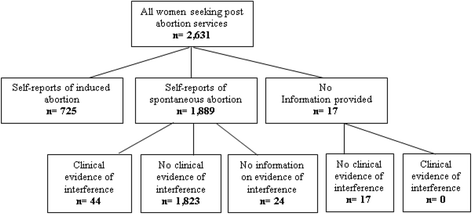Factors associated with repeat induced abortion in Kenya
- PMID: 26459344
- PMCID: PMC4604103
- DOI: 10.1186/s12889-015-2400-3
Factors associated with repeat induced abortion in Kenya
Abstract
Background: Over six million induced abortions were reported in Africa in 2008 with over two million induced abortions occurring in Eastern Africa. Although a significant proportion of women in the region procure more than one abortion during their reproductive period, there is a dearth of research on factors associated with repeat abortion.
Methods: Data for this study come from the Magnitude and Incidence of Unsafe Abortion Study conducted by the African Population and Health Research Center in Kenya in 2012. The study used a nationally-representative sample of 350 facilities (level II to level VI) that offer post-abortion services for complications following induced and spontaneous abortions. A prospective morbidity survey tool was used by health providers in 328 facilities to collect information on socio-demographic charateristics, reproductive health history and contraceptive use at conception for all patients presenting for post-abortion services. Our analysis is based on data recorded on 769 women who were classified as having had an induced abortion.
Results: About 16 % of women seeking post abortion services for an induced abortion reported to have had a previous induced abortion. Being separated or divorced or widowed, having no education, having unwanted pregnancy, having 1-2 prior births and using traditional methods of contraception were associated with a higher likelihood of a repeat induced abortion.
Conclusions: The findings point to the need to address the reasons why women with first time induced abortion do not have the necessary information to prevent unintended pregnancies and further induced abortions. Possible explanations linked to the quality of post-abortion family planning and coverage of long-acting methods should be explored.
Figures
Similar articles
-
Previous induced abortion among young women seeking abortion-related care in Kenya: a cross-sectional analysis.BMC Pregnancy Childbirth. 2016 May 14;16:104. doi: 10.1186/s12884-016-0894-z. BMC Pregnancy Childbirth. 2016. PMID: 27180102 Free PMC article.
-
Timing of abortion among adolescent and young women presenting for post-abortion care in Kenya: a cross-sectional analysis of nationally-representative data.BMC Womens Health. 2018 Feb 17;18(1):41. doi: 10.1186/s12905-018-0521-4. BMC Womens Health. 2018. PMID: 29452587 Free PMC article.
-
Contraception and abortion in Romania.Lancet. 1993 Apr 3;341(8849):875-8. doi: 10.1016/0140-6736(93)93074-b. Lancet. 1993. PMID: 8096575
-
Contraception and abortion knowledge, attitudes and practices among adolescents from low and middle-income countries: a systematic review.BMC Health Serv Res. 2018 Nov 29;18(1):909. doi: 10.1186/s12913-018-3722-5. BMC Health Serv Res. 2018. PMID: 30497464 Free PMC article.
-
Multiple induced abortions: Danish experience.Patient Educ Couns. 1997 May;31(1):83-9. doi: 10.1016/s0738-3991(97)01012-4. Patient Educ Couns. 1997. PMID: 9197806 Review.
Cited by
-
Assessment of early damage of endometrium after artificial abortion by shear wave elastography.Insights Imaging. 2020 Mar 4;11(1):28. doi: 10.1186/s13244-020-0841-4. Insights Imaging. 2020. PMID: 32128718 Free PMC article.
-
Post-abortion care with misoprostol - equally effective, safe and accepted when administered by midwives compared to physicians: a randomised controlled equivalence trial in a low-resource setting in Kenya.BMJ Open. 2017 Oct 10;7(10):e016157. doi: 10.1136/bmjopen-2017-016157. BMJ Open. 2017. PMID: 29018067 Free PMC article. Clinical Trial.
-
Policy, law and post-abortion care services in Kenya.PLoS One. 2018 Sep 21;13(9):e0204240. doi: 10.1371/journal.pone.0204240. eCollection 2018. PLoS One. 2018. PMID: 30240408 Free PMC article.
-
Factors associated with induced abortion among women of reproductive age attending selected health facilities in Addis Ababa, Ethiopia: a case control study.BMC Womens Health. 2020 Sep 3;20(1):188. doi: 10.1186/s12905-020-01023-4. BMC Womens Health. 2020. PMID: 32883263 Free PMC article.
-
Prevalence and factors associated with abortion and unsafe abortion in Nepal: a nationwide cross-sectional study.BMC Pregnancy Childbirth. 2018 Sep 17;18(1):376. doi: 10.1186/s12884-018-2011-y. BMC Pregnancy Childbirth. 2018. PMID: 30223798 Free PMC article.
References
-
- World Health Organization. Unsafe Abortion: Global and regional estimates of the incidence of unsafe abortion and associated mortality in 2008. In., 6 edn. Geneva: World Health Organization; 2011.
-
- Jagwe-Wadda G, Moore AM, Woog V. Occasional report. New York: Guttmacher Institute; 2006. Abortion morbidity in Uganda: evidence from two communities.
Publication types
MeSH terms
LinkOut - more resources
Full Text Sources
Other Literature Sources
Medical


